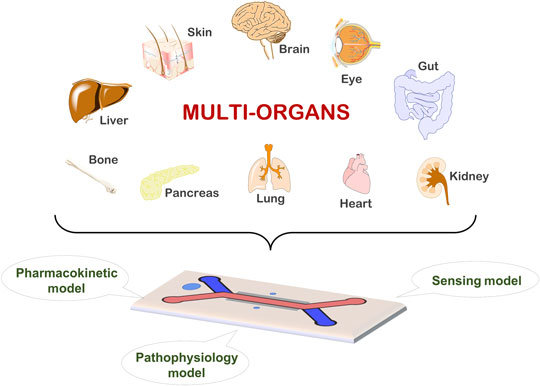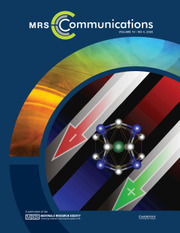Crossref Citations
This article has been cited by the following publications. This list is generated based on data provided by
Crossref.
Ruzycka, Monika
Cimpan, Mihaela R.
Rios-Mondragon, Ivan
and
Grudzinski, Ireneusz P.
2019.
Microfluidics for studying metastatic patterns of lung cancer.
Journal of Nanobiotechnology,
Vol. 17,
Issue. 1,
Li, Kaiyan
Yang, Xingyuan
Xue, Chang
Zhao, Lijuan
Zhang, Yuan
and
Gao, Xinghua
2019.
Biomimetic human lung-on-a-chip for modeling disease investigation.
Biomicrofluidics,
Vol. 13,
Issue. 3,
Wu, Qirui
Liu, Jinfeng
Wang, Xiaohong
Feng, Lingyan
Wu, Jinbo
Zhu, Xiaoli
Wen, Weijia
and
Gong, Xiuqing
2020.
Organ-on-a-chip: recent breakthroughs and future prospects.
BioMedical Engineering OnLine,
Vol. 19,
Issue. 1,
Rodrigues, Raquel O.
Sousa, Patrícia C.
Gaspar, João
Bañobre‐López, Manuel
Lima, Rui
and
Minas, Graça
2020.
Organ‐on‐a‐Chip: A Preclinical Microfluidic Platform for the Progress of Nanomedicine.
Small,
Vol. 16,
Issue. 51,
Tajeddin, Alireza
and
Mustafaoglu, Nur
2021.
Design and Fabrication of Organ-on-Chips: Promises and Challenges.
Micromachines,
Vol. 12,
Issue. 12,
p.
1443.
Maoz, Ben M.
2021.
Brain-on-a-Chip: Characterizing the next generation of advanced in vitro platforms for modeling the central nervous system.
APL Bioengineering,
Vol. 5,
Issue. 3,
Yadav, Vivek
Senapati, Satyajyoti
and
Chang, Hsueh-Chia
2022.
Ion-Depleting Action of Perm-Selective Membranes for Enhancing Electrical Communication and Gated Ion Channel Activity in Cell Cultures.
ACS Biomaterials Science & Engineering,
Vol. 8,
Issue. 11,
p.
4618.
Zommiti, Mohamed
Connil, Nathalie
Tahrioui, Ali
Groboillot, Anne
Barbey, Corinne
Konto-Ghiorghi, Yoan
Lesouhaitier, Olivier
Chevalier, Sylvie
and
Feuilloley, Marc G. J.
2022.
Organs-on-Chips Platforms Are Everywhere: A Zoom on Biomedical Investigation.
Bioengineering,
Vol. 9,
Issue. 11,
p.
646.
Yang, Yi
Chen, Yin
Wang, Liang
Xu, Shihui
Fang, Guoqing
Guo, Xilin
Chen, Zaozao
and
Gu, Zhongze
2022.
PBPK Modeling on Organs-on-Chips: An Overview of Recent Advancements.
Frontiers in Bioengineering and Biotechnology,
Vol. 10,
Issue. ,
Bhagat, Stuti
and
Singh, Sanjay
2022.
Micro/Nanofluidics and Lab-on-Chip Based Emerging Technologies for Biomedical and Translational Research Applications - Part B.
Vol. 187,
Issue. ,
p.
205.
Jehan, Zeenath
2022.
Biotechnology in Healthcare.
p.
131.
Qu, Jian
Liu, Yi
Li, Yan
Li, Jinjian
and
Meng, Songhe
2023.
Microfluidic Chip with Fiber-Tip Sensors for Synchronously Monitoring Concentration and Temperature of Glucose Solutions.
Sensors,
Vol. 23,
Issue. 5,
p.
2478.
Driver, Rishab
and
Mishra, Shweta
2023.
Organ-On-A-Chip Technology: An In-depth Review of Recent Advancements and Future of Whole Body-on-chip.
BioChip Journal,
Vol. 17,
Issue. 1,
p.
1.
Eftimie, Raluca
Mavrodin, A.
and
Bordas, Stéphane P.A.
2023.
Vol. 56,
Issue. ,
p.
323.
Kumar, Dhiraj
Nadda, Rahul
and
Repaka, Ramjee
2024.
Advances and challenges in organ-on-chip technology: toward mimicking human physiology and disease in vitro.
Medical & Biological Engineering & Computing,
Vol. 62,
Issue. 7,
p.
1925.
Abed, Heba
Radha, Remya
Anjum, Shabana
Paul, Vinod
AlSawaftah, Nour
Pitt, William G.
Ashammakhi, Nureddin
and
Husseini, Ghaleb A.
2024.
Targeted Cancer Therapy‐on‐A‐Chip.
Advanced Healthcare Materials,
Sailaja, Allika
and
Manisha, Bachchhav
2024.
Fostering Cross-Industry Sustainability With Intelligent Technologies.
p.
221.
Kim, Min-Hyeok
Lee, Yugyeong
Seo, Gwang Myeong
and
Park, Sungsu
2024.
Advancements in Kidney-on-Chip: Antibiotic-Induced Kidney Injury and Future Directions.
BioChip Journal,
Kuru, Cansu İlke
and
Ulucan-Karnak, Fulden
2024.
Lab-on-a-chip Devices for Advanced Biomedicines.
p.
221.



